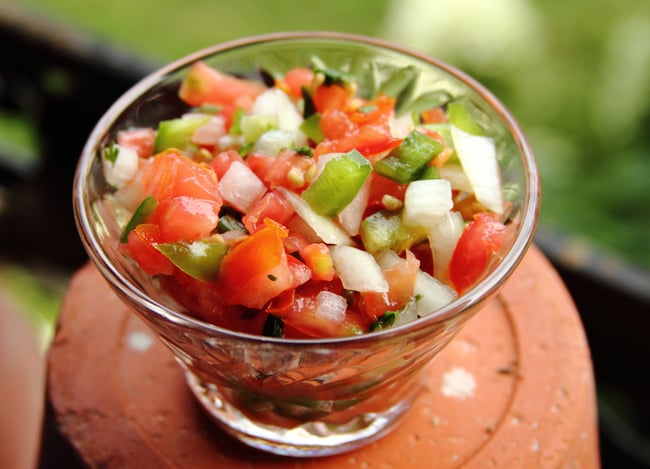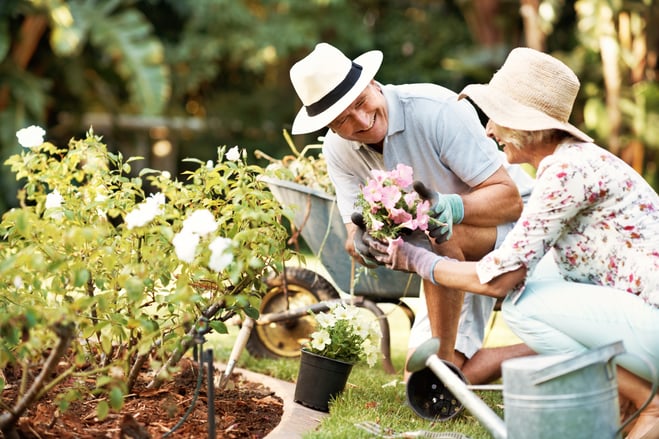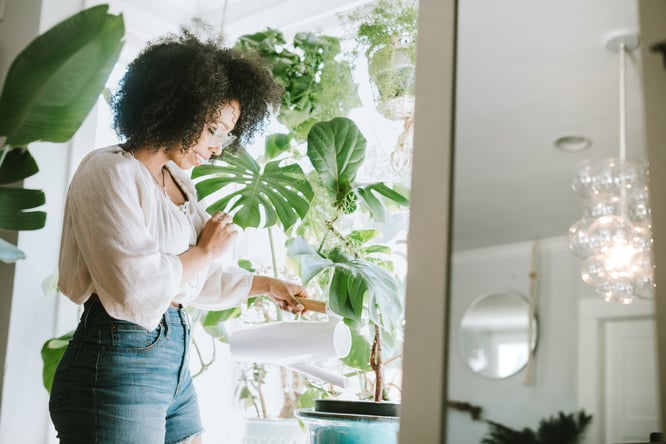
Jessica Brita-Segyde
It’s almost planting season…FINALLY! Time to plant your garden starts, do some landscape updates, and pretty-up your home’s interior with new greenery. Those of us who shop nurseries and home improvement stores know that that the choices are endless. If you need a place to start this year, read on. The following plants are easy to grow and beautiful to enjoy.
Outdoors – The Salsa Garden
You’ll get the most bang for your buck (and harvest for your time) if you plant a salsa garden. Think tomatoes, bell peppers, onions, garlic, and jalapenos. Cilantro and basil also belong in this group, though you could grow your herbs indoors as well. Here’s a rundown of the harvest from an experienced, though imperfect, salsa gardener:
 Tomatoes: The trick for tomatoes is to estimate when your final frost of spring will happen. Count back a few weeks from this date and plant your seedlings indoors. Once the threat of frost has subsided, your baby plants can be transplanted outdoors. If you’re not sure about the frost date, transplant your starts into a large pot that can be moved back indoors if needed. Also, have some stakes or caging ready to support your tomato vines once they begin to mature. Tomatoes are dense and heavy and will lay on the ground if you don’t support them. When they lay on the ground they get bugs.
Tomatoes: The trick for tomatoes is to estimate when your final frost of spring will happen. Count back a few weeks from this date and plant your seedlings indoors. Once the threat of frost has subsided, your baby plants can be transplanted outdoors. If you’re not sure about the frost date, transplant your starts into a large pot that can be moved back indoors if needed. Also, have some stakes or caging ready to support your tomato vines once they begin to mature. Tomatoes are dense and heavy and will lay on the ground if you don’t support them. When they lay on the ground they get bugs.
Garlic: This is a choice favorite. It’s easy to grow and tastes so much better from a garden! Plant your garlic in the fall for harvest in late spring. If you’re too late for garlic planting this year, take this opportunity to buy several varieties of garlic throughout the summer months so you can cook and experiment to find out which is your favorite. When you’re ready to plant, crack your bulb of choice into individual cloves before you bury them. You can plant any variety, give it some good soil, and enjoy winter while your bulbs hibernate. They should sprout in mid-spring. However, if some green shoots show up early don’t worry. Most gardeners just leave them alone and they somehow survive.
Many gardeners say the flavor of their garlic peaks at the third season and then stays fragrant and wonderful year after year. When it is time to harvest, you will hardly be able to wait to start pulling! Garlic is such a fantastic homegrown crop that there’s even a “classic” book on the subject. If you love garlic too, then check out Ron L. Engeland’s Growing Great Garlic (pub. 1991).
 Onions: Onions are almost as easy to grow as garlic. There are a ton of varieties, but the smaller onions are the way to go. They grow quickly and make better sense for salsa – you don’t have to do much chopping before throwing them into the blender or food processor. Onions are usually ready to harvest when the long, green shoots get heavy and start to fold over. The shoots may also begin to turn yellow before falling.
Onions: Onions are almost as easy to grow as garlic. There are a ton of varieties, but the smaller onions are the way to go. They grow quickly and make better sense for salsa – you don’t have to do much chopping before throwing them into the blender or food processor. Onions are usually ready to harvest when the long, green shoots get heavy and start to fold over. The shoots may also begin to turn yellow before falling.
Jalapenos: Don’t let their spicy reputation intimidate you. Jalapenos are easy to grow! There are many varieties and the seed manufacturers will do their best to assign a spice level. Soil conditions can also affect the spice and every palette is different, so you should plant at least two varieties in case one is too hot or too mild for your taste.
Bell Peppers: Bell peppers are the most difficult plant to grow, but not impossible. They’re a bit larger than the jalapenos and seem to be attractive to pests (insects as well as bunny rabbits). Keep an eye on your bell peppers and make sure to water them as frequently as you water your tomatoes. The extra labor is worth the reward, though. Homegrown bell peppers are flavorful, crunchy, and full of vitamin C. Bell peppers, like jalapenos, take about 70 days to mature.
Herbs: Cilantro and flat-leaf basil can be grown indoors or out. Many people will start them indoors, but if you have any feline companions, they will likely eat them, so you may need to find a creative place your pets can’t get to in order to give them a strong start. Once they’re an inch or two tall you can transplant them near the edge of the garden right next to the tomato plants. The herbs seem to grow well near the tomatoes. Let the plants grow large and take a few snips off each plant as-needed. If you have an abundance still growing by the end of the season, you can cut the plants at the base and dry them indoors for use throughout the winter.
Outdoors – Landscaping 101
Landscape plants are the toughest to tackle. You can plant babies and hope for the best, or you can pay a hefty price for mature plants and have them planted and pruned by a professional. It is advised to at least consult with a landscape artist or Master Gardener before you take on any major landscaping projects as this is an area best-handled by an educated advisor.
If you’re just looking to add one or two new plants, here are some options that will help boost your home’s curb appeal:
Jonquils (northern climate): The jonquil is a pretty perennial. It’s technically a type of daffodil and grows from a bulb. Proper planting is key. Your bulbs should be 10-12 inches deep and covered with fertile soil. If you plant them at the proper depth they’ll flower year after year. Also, after the flowers have bloomed and faded, cut the stems down to one inch above the soil. This seems to help the plants stay healthy.
Boxwood (northern climate): Boxwood shrubs are a popular landscape shrub, and for good reasons. You can get a decent-sized boxwood for under $30 and they’ll usually root well even when planted by a novice. They only require a moderate amount of water and look appropriate almost anywhere. Boxwoods do require a yearly pruning or the branches will start to curve and look awkward.
Amaryllis (southern climate): This next recommendation comes from homeowner, Emily Kuntz, who has lived all over the U.S. For the past several years Emily lived in Huston, Texas and grew roots (literally!) by planting a drought-tolerant landscape. Emily offered the following insight into her experience with this surprisingly hardy flower, “My amaryllis in Texas behaved much like irises do up in Indiana, laying down new bulbs each year.”
Variegated ginger (southern climate): Emily also recommended variegated ginger as an easy landscaping choice for southern homeowners. This beautiful plant has delicate seashell flowers and will leave you thinking about Florida vacations! Emily’s take on variegated ginger sums up what every grower is looking for in an easy plant choice, “I never watered it, but it grew fuller and fuller every year.”
Indoors – The Big 3
1. Aloe Vera. The aloe plant is the queen of the windowsill. She requires sunlight but not much water, so you can basically set up your aloe and forget about it. Aloe is a succulent, after all. The kitchen is the perfect room for an aloe plant because the gel comes in handy for treating minor burns and scrapes. Just break the tip of a shoot off and apply some of the gel to the affected skin. Some people even stir aloe vera gel into tea or water and drink it, claiming that aloe is good for their digestive system.
 2. Spider Plant. The spider plant is a quintessential hanging plant. Many homeowners will hang them in the kitchen in macramé baskets attached to the ceiling. While there’s still a place for macramé floral patterns in retro design, spider plants are a nice choice for modern design as well. Try hanging them in silver or gold pots, for rooms decorated with a light industrial theme. If you have a cat, though, keep this plant far out of his or her reach. Spider plants are toxic yet irresistible to felines. Water once a week and make sure your spider plant is close enough to a window to get some sun. On mild spring days you can take your spider plant on an outdoor field trip and hang it on a shepherd’s hook for a little extra sunshine!
2. Spider Plant. The spider plant is a quintessential hanging plant. Many homeowners will hang them in the kitchen in macramé baskets attached to the ceiling. While there’s still a place for macramé floral patterns in retro design, spider plants are a nice choice for modern design as well. Try hanging them in silver or gold pots, for rooms decorated with a light industrial theme. If you have a cat, though, keep this plant far out of his or her reach. Spider plants are toxic yet irresistible to felines. Water once a week and make sure your spider plant is close enough to a window to get some sun. On mild spring days you can take your spider plant on an outdoor field trip and hang it on a shepherd’s hook for a little extra sunshine!
3. Bamboo Palm. This plant has made its way to many offices, salons, and homes. A little research confirmed that bamboo palms are known for improving indoor air quality. If this seems like the perfect news for you, you can order your first bamboo palm from Amazon.com. These will grow larger if you increase the size of their planter and they may even flower down the road. Also, the ASPCA reports that bamboo palms are non-toxic to cats, so no worries there!
Hopefully you found some useful ideas in this sampling of easy-to-grow plants. Just one or two new varieties added to your home, garden, and landscape can make a big difference. Happy growing!
.png?width=375&height=150&name=MicrosoftTeams-image%20(63).png)
